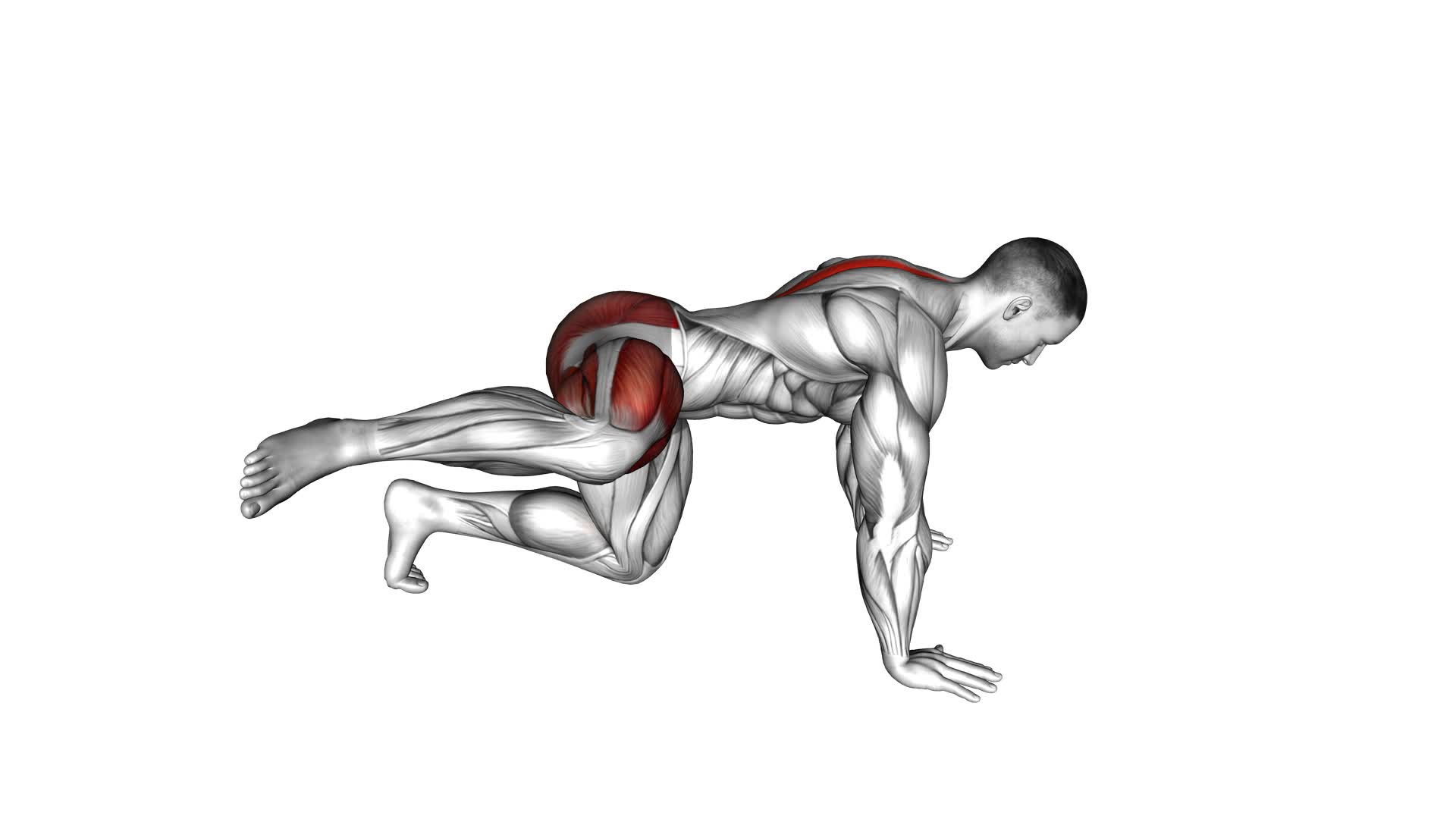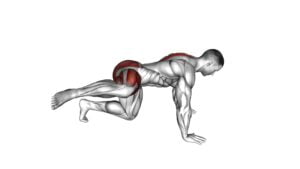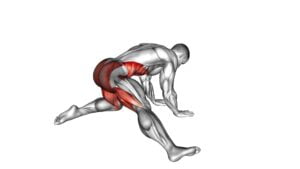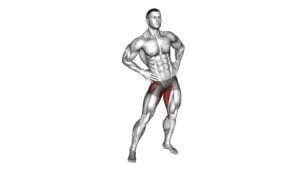Kneeling Backward Hip Circles – Video Exercise Guide & Tips

Get ready to strengthen and stretch your hips with kneeling backward hip circles!
Watch This Exercise Video
This exercise is a great way to improve mobility and stability in your hip joints. In this video exercise guide, you'll learn the proper form and technique, as well as common mistakes to avoid.
Plus, we'll provide modifications and progressions to suit your fitness level.
So grab a mat and get ready to circle your way to stronger hips!
Key Takeaways
- Kneeling backward hip circles improve hip mobility, core and hip muscle strength, range of motion, stability, and balance.
- Proper form includes kneeling on a soft surface, placing hands on the ground for support, extending one leg out to the side, and making circular motions with the extended leg.
- Variations of kneeling backward hip circles include using ankle weights or resistance bands, starting with an appropriate challenge level, and exploring different variations for engagement.
- Consistency and frequency are important for optimal results, gradually increasing intensity and frequency over time while listening to your body and adjusting accordingly.
Benefits of Kneeling Backward Hip Circles
You can experience several benefits from incorporating kneeling backward hip circles into your workout routine. These exercises are particularly effective for improving hip mobility and strengthening the surrounding muscles.
Hip mobility is essential for proper movement and functionality in daily activities and sports. By performing kneeling backward hip circles, you can increase the range of motion in your hips, allowing for smoother and more fluid movements. This can be especially beneficial for athletes or individuals who engage in activities that require a wide range of hip motion, such as dancing or martial arts.
In addition to improving hip mobility, kneeling backward hip circles also help strengthen the muscles in and around your hips. This includes the glutes, hip flexors, and core muscles. Strengthening these muscles can enhance stability and balance, reducing the risk of injuries and improving overall performance. Strong hip muscles also contribute to better posture and alignment, which can alleviate lower back pain and improve overall body mechanics.
Incorporating kneeling backward hip circles into your workout routine can provide numerous benefits for both your hip mobility and muscle strength. Whether you're an athlete looking to enhance your performance or simply want to improve your overall fitness, these exercises are a valuable addition to any exercise program.
Equipment Needed for the Exercise
To perform kneeling backward hip circles, gather the necessary equipment. Luckily, you don't need any fancy or specialized equipment for this exercise. All you need is a comfortable mat or cushion to kneel on, and enough space around you to move freely. Make sure your mat or cushion provides enough support for your knees, as you'll be kneeling throughout the exercise.
If you have any knee issues or find it uncomfortable to kneel for an extended period, you can modify the exercise by using a yoga block or a folded towel under your knees for added support. This modification can help alleviate any discomfort and allow you to focus on the movement without straining your knees.
Now that you know what equipment you need, let's move on to the next section, which will guide you through the proper form and technique for performing kneeling backward hip circles. Remember, it's important to maintain proper form to maximize the benefits of the exercise and prevent any injuries.
Proper Form and Technique
Maintain a strong and controlled movement throughout the kneeling backward hip circles exercise.
This exercise is an excellent option for improving hip mobility and strengthening the glutes.
To perform this exercise correctly, start by kneeling on the ground with your knees hip-width apart and your hands on your hips.
From this position, engage your core and slowly move your hips in a circular motion, going backward.
Make sure to keep your movements controlled and avoid any jerking or bouncing.
As you circle your hips backward, focus on feeling a stretch in your hip muscles.
Continue the movement for the desired number of repetitions and then switch directions to circle your hips forward.
Remember to breathe throughout the exercise and listen to your body's limits.
Common Mistakes to Avoid
When performing kneeling backward hip circles, it's important to avoid common mistakes that can hinder your results.
One common mistake to avoid is incorrect hip positioning, which can lead to improper form and reduced effectiveness of the exercise.
Additionally, make sure to engage your core muscles throughout the movement to avoid relying solely on momentum.
Incorrect Hip Positioning
Ensure proper hip alignment to avoid common mistakes while performing kneeling backward hip circles.
Correct hip positioning is crucial for both the effectiveness and safety of this exercise. Improper alignment can lead to strain or injury in the hips and lower back.
To maintain the correct hip alignment, make sure your hips are squared and facing forward throughout the movement. Avoid leaning too far forward or backward, as this can put unnecessary pressure on the hips.
Additionally, ensure that your hip flexibility is adequate before attempting this exercise. Tight hips can restrict your range of motion and increase the risk of injury.
By maintaining proper hip alignment and flexibility, you can maximize the benefits of kneeling backward hip circles while minimizing the risk of discomfort or injury.
Now let's move on to another common mistake – lack of core engagement.
Lack of Core Engagement
To avoid making the common mistake of lacking core engagement during kneeling backward hip circles, focus on actively contracting your abdominal muscles throughout the exercise. Engaging your core is crucial for improving balance and strengthening your lower back. By consciously activating your abdominal muscles, you stabilize your spine and pelvis, allowing for better control and range of motion during the movement. This engagement also helps to prevent excessive strain on your lower back and promotes proper alignment.
Remember to maintain a neutral spine position and avoid overarching or rounding. By actively engaging your core, you enhance the effectiveness of the exercise and reduce the risk of injury.
Now that you understand the importance of core engagement, let's move on to discussing modifications and progressions to further challenge yourself in the kneeling backward hip circles.
Modifications and Progressions
How can you modify and progress the kneeling backward hip circles exercise?
If you're looking for alternative exercises to target your hips and improve mobility, you can try the kneeling hip flexor stretch or the kneeling glute stretch. These exercises will help to stretch and strengthen the hip muscles, providing a good foundation for the kneeling backward hip circles.
To progress the kneeling backward hip circles, you can add resistance by using a resistance band around your ankles. This will increase the intensity of the exercise and challenge your hip muscles even further. You can also try performing the circles on an unstable surface, such as a balance disc or a foam pad. This will engage your core muscles to a greater extent and improve your balance and stability.
Incorporating kneeling backward hip circles into your fitness routine can be beneficial for improving hip mobility and strengthening the core and hip muscles. By performing this exercise regularly, you can enhance your overall athletic performance and reduce the risk of injuries.
Now that you understand the modifications and progressions for the kneeling backward hip circles, let's move on to some tips for incorporating this exercise into your routine.
Tips for Incorporating Kneeling Backward Hip Circles Into Your Fitness Routine
To effectively incorporate kneeling backward hip circles into your fitness routine, consistency is key in order to reap the benefits of improved hip mobility and strengthened core and hip muscles. By performing this exercise regularly, you can increase the range of motion in your hips, which can be beneficial for activities such as running, squatting, and lunging. Additionally, kneeling backward hip circles also engage your core and hip muscles, helping to improve stability and balance.
To get started, begin by kneeling on a soft surface with your knees hip-width apart and your hands on the ground in front of you for support. From this position, extend one leg straight out to the side, keeping your foot flexed. Slowly begin to make circular motions with your extended leg, moving it backward and then bringing it back to the starting position. Repeat this motion for a set number of repetitions before switching to the other leg.
To add variation to your kneeling backward hip circles, you can try performing them with ankle weights for added resistance. Another option is to use a resistance band around your thighs to increase the activation of your hip muscles. Remember to start with a weight or resistance that challenges you but still allows you to maintain proper form throughout the exercise.
Incorporating kneeling backward hip circles into your fitness routine can be a great way to improve hip mobility and strengthen your core and hip muscles. Remember to stay consistent and gradually increase the intensity as you become more comfortable with the exercise.
Frequently Asked Questions
How Many Reps and Sets Should I Do of Kneeling Backward Hip Circles?
To determine the number of reps and sets for kneeling backward hip circles, consider your fitness level and any knee injuries you may have.
Start with 2 to 3 sets of 10 to 15 reps.
If you're a beginner or have a knee injury, start with fewer reps and sets and gradually increase as you build strength and mobility.
Always listen to your body and consult with a professional if you have any concerns.
Can I Do Kneeling Backward Hip Circles if I Have a Knee Injury?
Yes, you can modify kneeling backward hip circles if you have a knee injury.
It's important to listen to your body and not push yourself too hard.
You can decrease the range of motion or perform the exercise with smaller circles.
It's always a good idea to consult with a healthcare professional or a physical therapist to determine if kneeling backward hip circles would be beneficial for your specific rehabilitation needs.
Are Kneeling Backward Hip Circles Suitable for Beginners?
Kneeling backward hip circles are a great exercise for beginners. They can help improve hip mobility and strengthen the muscles in your hips and core. If you're new to this exercise, there are modifications you can make to make it easier and more comfortable.
Can Kneeling Backward Hip Circles Help With Hip Mobility?
Kneeling backward hip circles can definitely help improve your hip mobility. By engaging the muscles surrounding your hip joint, these exercises can increase your range of motion and flexibility.
Additionally, there are variations and modifications available for beginners or those with specific needs. These variations can be helpful in gradually building strength and avoiding any discomfort or strain.
Is It Normal to Feel Discomfort or Tension in the Hips While Performing Kneeling Backward Hip Circles?
Feeling discomfort or tension in your hips while doing kneeling backward hip circles is normal. It could be a sign that you're stretching and mobilizing the hip joints.
However, if the discomfort is severe or causes pain, you may need to modify the exercise. To deepen the stretch, try placing a cushion under your knees or moving your hips in smaller circles.
Avoid common mistakes like hunching your back or forcing the movement.
Conclusion
Incorporating kneeling backward hip circles into your fitness routine can provide numerous benefits, including improved flexibility and mobility in the hip joints. By following proper form and technique, avoiding common mistakes, and making modifications or progressions as needed, you can safely and effectively perform this exercise.
Remember to consult with a fitness professional before attempting any new exercise, and always listen to your body to prevent injury.
Start incorporating kneeling backward hip circles into your workouts to enhance your hip mobility and overall fitness.

Author
Years ago, the spark of my life’s passion ignited in my mind the moment I stepped into the local gym for the first time. The inaugural bead of perspiration, the initial endeavor, the very first surge of endorphins, and a sense of pride that washed over me post-workout marked the beginning of my deep-seated interest in strength sports, fitness, and sports nutrition. This very curiosity blossomed rapidly into a profound fascination, propelling me to earn a Master’s degree in Physical Education from the Academy of Physical Education in Krakow, followed by a Sports Manager diploma from the Jagiellonian University. My journey of growth led me to gain more specialized qualifications, such as being a certified personal trainer with a focus on sports dietetics, a lifeguard, and an instructor for wellness and corrective gymnastics. Theoretical knowledge paired seamlessly with practical experience, reinforcing my belief that the transformation of individuals under my guidance was also a reflection of my personal growth. This belief holds true even today. Each day, I strive to push the boundaries and explore new realms. These realms gently elevate me to greater heights. The unique combination of passion for my field and the continuous quest for growth fuels my drive to break new ground.







